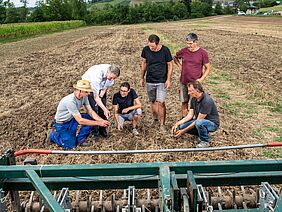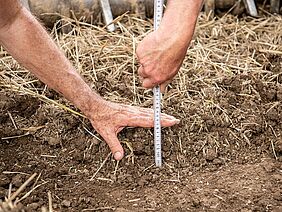Ploughing has a long tradition. But while the early ploughs were drawn by humans or animals and could not delve deep into the soil, industrialisation gave rise to heavy machinery with deep working depths. The resulting consequences include furrow compaction, deterioration in soil structure, soil surface erosion and humus decomposition. The change in mindset first came in the US on foot of massive wind erosion. It gave rise to the direct seeding movement or "no-till". Is it a solution for everyone? Not really, given that direct seeding calls for herbicides for weed control – a taboo for organic farmers. They did however want to integrate this more careful form of soil cultivation into organic management. At the start of the new millennium, Swiss organic farmers approached FiBL with ideas for how to reduce their traditional management to very shallow cultivation using modern machinery, and to do so without resorting to herbicides. FiBL took the issue on board and started a long-term trial in Frick, Switzerland, in the autumn of 2002 together with practitioners and advisors. Given that the soil in Frick with its high proportion (40-50 per cent) of clay is not representative of all of Switzerland, FiBL launched a second long-term trial in 2010 on the loess soil of the Schlatthof farm in Aesch in the canton of Basel-Landschaft.
Long-term trials deliver sought-after data
At this stage a significant archive of samples and data has been compiled. The long-term trials thus provide a platform hugely valuable to FiBL for project partnerships and are a basis for detailed investigations. Both trials were integrated into several major national and European-level projects, giving rise to 28 scientific publications by 2020. A summary of the results from the trial in Frick was published in early 2020 in the renowned scientific journal "Scientific Reports". Investments into long-term trials are clearly worthwhile. And there is much more to come, given that such trials become ever more interesting the longer they run. Many questions have yet to be answered – on soil physics, humus quality or biodiversity, for instance. The trials have already shed a great deal of light on the impacts of reduced soil cultivation in organic agriculture. They have shown, for example, that crop yields in reduced tilled soils can be expected to be slightly lower than those from ploughed ones. Forage crops however yield approximately the same. Under reduced tillage, yields fluctuate more strongly overall. Reduced tillage works best, the better the weather in springtime with its associated soil warming and nitrogen mineralisation. However, a problem that has yet to be solved is the increase in weeds, especially in rhizomatous weeds.
Reduced tillage benefits for soils and climate
Reduced tillage is highly beneficial to soil life, giving rise to a greater abundance of earthworms and microorganisms such as mycorrhizal fungi. Another major advantage is the accumulation of humus in the topsoil. Humus is also vital to the cohesion of the soil and aids in erosion control. The more clayey the soil, the greater its potential to store soil organic matter. Reduced soil cultivation scores higher when it comes to soil protection and, in parts, climate protection: the clayey soil of the Frick trial sequestered an additional 700 kg of carbon per hectare compared to its ploughed counterpart.
New techniques trialled together with farmers
Tillage systems were not only compared in the longterm trials but also on 15 further agricultural holdings. New machinery as well as techniques, such as ley termination with non-inversion tillage, direct seeding without any soil cultivation as well as a variety of green manures, have been tested in numerous field trials. By sharing their experiences and attending field visit and machinery presentations organised by FiBL, the farmers involved in the network engaged in a continuous process of learning from each other and improving their practice. Videos and information leaflets documented and systematised these experiences for practical use. The following conclusions can be drawn from the field trials to date: A strict reduced tillage regime is easier to implement on farms with simpler crop rotations and good soil conditions than on farms producing more specialised crops or those dealing with heavy or stony soils. Farms in drier regions benefit more from reduced tillage. A successful regime generally requires investment in a shallow cultivator, a rotavator or shallow plough and adaptation of the crop rotation. A close eye must be kept on rhizomatous weeds at all times.
Funding through direct payments achieved
There has also been a political success: Together with the reduced tillage movement, FiBL advocated for a special "conservation tillage" module as part of the federal-level amendment of the Swiss Ordinance on Direct Payments in Agriculture in 2014. This provision is still in force today and as a result organic farmers have been benefiting from direct payments for reduced tillage to a maximum working depth of ten centimetres as well as from an additional payment for refraining from herbicide use. Thanks to this financial aid and thanks to model farms and newly developed machinery, reduced tillage has now been adopted by some 25 per cent of organic holdings – a great success.
Conclusions from trials on reduced tillage
Reduced tillage cultivation
- improves soil life and humus formation compared to ploughing
- delivers climate change mitigation potential
- results on average in a slight reduction in yields and increases weed pressure compared to ploughing
- requires investment in new machinery and adaptation of the crop rotation
- can be well implemented on organic farms with simpler crop rotations and good soil conditions as well as in rather dry regions
Further information
Contact
Links
- fibl.org: Activity report
- fibl.org: Project NUE-Crops
- fibl.org: Trial KLINE AG (in German)
- fibl.org: Project Coop BKBA
- fibl.org: Project TILMAN-ORG
- fibl.org: Project FertilCrop
- fibl.org: Project iSqaper
Download
- fibl.org: Fact sheet "Reduzierte Bodenbearbeitung" (in German)





